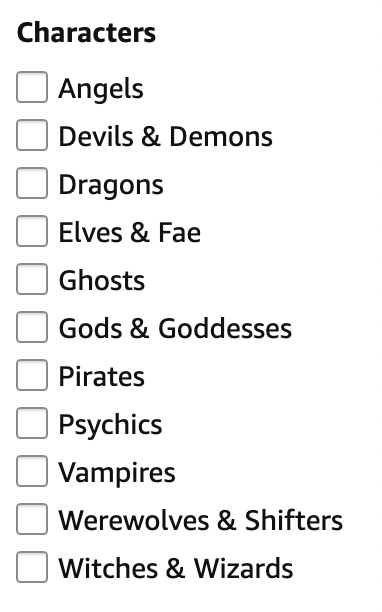Find Your Exact Genre, Find Your Lifelong Book Ambassadors by Shayla Raquel
This blog post was written by a human.Hi readers and writerly friends!
If you’re a returning reader, welcome back and if you’re new here, thanks for stopping by! For this post, fellow Oklahoma Freelance Editor Shayla Raquel is taking over the blog to tell you all about how to not only grow your audience but how to transform readers into lifelong ambassadors of your book! This post shows you exactly how to gain a clear understanding of your genre and target audience to grow an enduring, loyal readership! Be sure to leave her a comment and check out her website and other socials!
A best-selling author and public speaker, Shayla Raquel teaches people the ins and outs of writing, publishing, and marketing their books. Her in-person and online classes focus on author branding, self-publishing, book marketing, and the craft of writing.
She is the author of the Pre-Publishing Checklist, “The Rotting” (in Shivers in the Night), The Suicide Tree, The 10 Commandments of Author Branding, All the Things I Should’ve Told You, and “Savage Indulgence.”
In her not-so-free time, she studies all things true crime and obsesses over squirrels. She lives in Oklahoma with her husband and three fur babies.
More recently, Shayla has served as the founder of an incredible non-profit organization based in McLoud, Oklahoma, called Crime & Compassion Inc., through which she helps incarcerated women find their voices and share their stories with the world through their writing.
Shayla Raquel, best-selling author, public speaker, and book editor.
Why Do I Need To Know My Target Audience?
Investing time and money into social media, email newsletters, Amazon ads, podcast interviews, and blog posts will net you very little ROI if you do not know your precise genre.
Because if you don’t know exactly what book you wrote, then, my friend, you don’t know your audience.
And if you don’t know your audience, what good is all that time and money you’ve put toward marketing your book?
My goal today is to teach you how to determine your exact genre as a novelist so you can pinpoint your target audience. Once you do that, you can have lifelong book ambassadors: people who fangirl over your book and tell the world about it.
Amazon Kindle Categories. Photo by Shayla Raquel.
So, What Is Your Genre?
If I ask an author, “What book is your genre?” and they reply “Fantasy,” I get a little worried.
Go to Amazon.com and toggle the search bar from All Departments to Kindle Store. On the left-hand side of your screen, select Kindle eBooks. (We don’t need the newsstand or singles or anything like that.)
Next, select Categories. It’s easy to miss sometimes because Amazon doesn’t make it prominent, but it’s usually under the search bar or off to the left-hand side.
Next, for this purpose, select Science Fiction & Fantasy. Narrow it down once more by selecting Fantasy. There are over 50,000 e-books in the Fantasy category alone. That’s a lot of competition.
Now you have to determine where your novel fits in the world of fantasy. Before I explain, I have a very important note: I desperately wish authors would do this exercise before writing their novels. If they did, then they’d ensure their story fit within the expected storylines of, let’s say, Gaslamp Fantasy or Arthurian Fantasy.
Next, select Fantasy. Photo by Shayla Raquel.
My point: Your novel will be difficult to sell if you wrote it without knowing its genre. You can figure it out, but it’s a little bit tougher because there’s a chance there are several genres packed into one story. (I did this with my first novel, so don’t be like Shayla!)
Okay, now that you have a warning to heed, let’s move on to subgenres.
So here you are in the Fantasy genre for Kindle e-books with all this competition. Where does your book fit? If your subgenre is Action & Adventure, that’s more specific than just saying Fantasy, but could you niche it down even more by mentioning the types of characters? (Amazon gives us a handy checklist for various genres.) If you have Elves or Fae, that officially means you’re only competing with 1,000 e-books now!
Elves. Photo by Shayla Raquel.
Your genre would be, let’s say, Fae Action & Adventure Fantasy.
Let’s shift to Mystery, Thriller & Suspense. If you’re going to find your niche, I suggest looking into Moods & Themes (another handy checklist). If I write Crime Fiction (50,000 e-books in this genre), I have several subgenres within that too:
Heist
Kidnapping
Murder
Noir
Organized Crime
Serial Killers
Vigilante Justice
Crime Fiction. Photo by Shayla Raquel.
But I have the opportunity to get super specific by selecting a mood or theme, such as Action-Packed. Therefore, it would be: Action-Packed Heist Crime Fiction.
Action Packed. Photo by Shayla Raquel.
It gets better! I can also look into Settings (beaches, islands, mountains, etc.) and Characters (amateur sleuths, British detectives, gay protagonists, etc.) on the Amazon checklist.
Setting. Photo by Shayla Raquel.
Characters. Photo by Shayla Raquel.
If your story has some love in it, you would go to the Romance category and narrow it down to, maybe, Time Travel. On the left-hand side, take a look at Romantic Heroes and Romantic Themes (originally called Tropes). By narrowing the genre down to Viking Time Travel Romance, I have certainly found a very specific group of readers!
Vikings. Photo by Shayla Raquel.
Now What?
Now that you know some tricks for finding your exact genre, you have a foundation for marketing your book to the right audience. And marketing it well.
But how do you get book ambassadors to see your book?
It depends on the platform, of course. If you label your categories and keywords properly through Amazon KDP and Amazon Author Central, you’ve just made your life way easier. (To learn how to request 8 additional categories and how to find keywords, read 5 Freakishly Helpful Amazon Tricks Every Author Should Use.)
Outside of Amazon, your blurb (back cover copy and Amazon product description) must reflect your genre. In addition to a steller book cover, a blurb helps sell your book. It’s your big flashy billboard: it’s meant to suck the reader right in.
When writing a blurb, follow these steps:
Drop the Hook — A hook is meant to entice the reader to bite. I love this hook from The Martian by Andy Weir: “Six days ago, astronaut Mark Watney became one of the first people to walk on Mars. Now, he’s sure he’ll be the first person to die there.”
Dangle the Characters — Reel them in with intriguing characters.
Dive into Conflict — Show them what this book is all about. What’s the plot? Why should the reader buy this book?
Determine the Consequences — What hangs in the balance for your characters? Formula: Conflict (“Character must do this”) + Stakes (“Or this will happen”) = Consequences.
Dine on the Big Question — End your blurb on an intriguing question or a point of tension—something that will convince the reader to take a chance on buying your book.
For the complete how-to, read Writing Compelling Book Blurbs.
If you’ve got these things down (genre, Amazon, and blurb), you need to spend quality time putting your book in front of people on various platforms to determine where you get the most bites (from readers who want to chow down on your genre). It could be through any one of these avenues:
Social media (especially TikTok)
Email newsletter (your own)
Podcasts (interviews specifically)
Book promotion newsletters (Book Gorilla, Many Books, Book Rebel, etc.)
Amazon ads
Social media ads
Book reviewers (YouTube, Instagram, and TikTok are full of reviewers)
Blogs
Some platforms work better than others for a variety of reasons, but you won’t know until you try and stay committed long enough to determine if it’s worth the ROI. If you write sexy stories, there is a community with 4.2 billion views on TikTok called SmutTok just waiting for you. If you want your book to be reviewed, there are loads of BookTubers on YouTube ready and willing to geek out over your book.
If you will do the hard work of determining exactly what you write, it will be smoother sailing when it’s time to find your readers.
Best of luck!
Thanks for reading Shayla’s guest blog post! I hope you enjoyed it and found her advice useful and actionable! If you liked this post, please leave us a comment below and don’t forget to check out the other posts on the blog!
Bibliography
Raquel, Shayla. “Find Your Exact Genre, Find Your Lifelong Book Ambassadors.” Blog Post article and photos, February 3, 2023.furkanfdemir. “Classic wooden shelves with assorted books in store” (Thumbnail photo). Pexels photo, December 28, 2020.
Further Reading
“Writing Compelling Blurbs: Book Descriptions to Entice Your Reader.” by Shayla Raquel, June 28, 2022.“How Not to Launch a Self-Published Book: 7 Easy Steps for Indie Authors.” by Shayla Raquel, October 18, 2022.“Bad Book Marketing: Three Things Authors Need to Stop Doing Immediately.” by Shayla Raquel, March 20, 2022.“5 Freakishly Helpful Amazon Tricks Every Author Should Use (2022).” by Shayla Raquel, January 17, 2022.Or you can just check out all of Shayla’s blog posts about book marketing here!Crime & Compassion Inc.—Literature written by those who were written off—a 501(c)(3) registered nonprofit in Oklahoma.
More Like This
8 Reasons Why Having A Creative Community MattersThe Importance of Befriending Your Competition20 Tips and Tricks for a Successful Email NewsletterBook Marketing 101: Everything Writers Need To Know About Literary Agents and QueryingSee all Marketing blog posts.
Related Topics
8 Ways To Level Up Your Workspace And Elevate Your ProductivityYoga For Writers: A 30-Minute Routine To Do Between Writing SessionsHow To Overcome Writer’s BlockWriting Every Day: What Writing As A Journalist Taught Me About Deadlines & DisciplineWhy Fanfiction is Great Writing Practice and How It Can Teach Writers to Write WellCheck out my other Writing Advice blog posts!
Before You Go
Looking for your next read? I've got you covered. See my Reading Recommendations and Reading Challenges for ideas about what to read next!Oh, and don't forget to Get Your FREE Story Binder Printables e-Book!




















